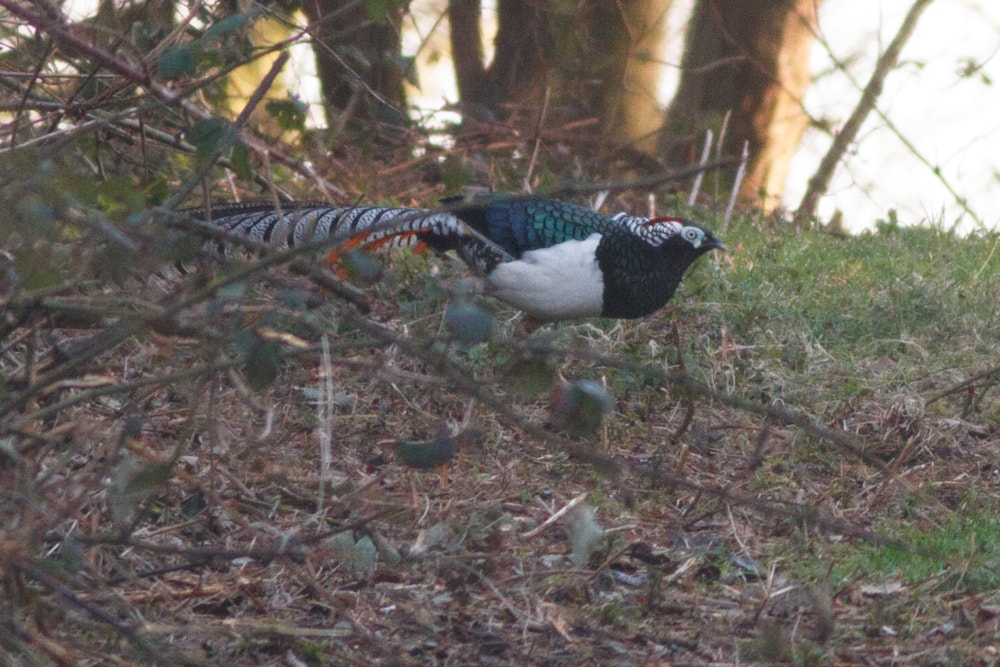After the species' intentional introduction at Woburn in the 1890s, the main British population of Lady Amherst's Pheasant established itself along the Greensand Ridge of Bedfordshire, spreading naturally west into Buckinghamshire. The extensive mixed pine, ash, oak and beech woodlands in the area (with an introduced rhododendron understorey) appear to have made a passable analogue for its native deciduous forest and bamboo thickets. However, similar habitat elsewhere in Britain seems to have been unable to sustain numerous other introduction attempts over the last two centuries.
Native to south-western China and Burma, Lady Amherst's Pheasant was added to the British Ornithological Union's British List in 1971 on the basis of the Bedfordshire and Buckinghamshire population, which by then was estimated to have reached up to 200 pairs during surveys at the time for the British Trust for Ornithology's The Atlas of Breeding Birds in Britain and Ireland.

Lady Amherst's Pheasant, Lidlington, Bedfordshire (Josh Jones).
By the late 1980s, the Bedfordshire population had already undergone a notable decline, with a male-heavy ratio of around 65-75 per cent (though females are harder to detect and identify), and there were apparently no more than 40 individuals of the species by 2001. By 2008 it was thought that just five male 'Lady A's remained, with two reported last year; only one male has been seen so far in 2015. Reasons for this decline have been mooted as loss of habitat, degradation of the understorey – particularly from grazing by the also introduced Chinese Muntjac – increased predation, disturbance (including by birders) and inbreeding within a very small gene pool.
By any interpretation this looks like an extinction curve, and with the species only present in Britain for about 125 years – at times artificially fed – it could be argued that this species was never a true part of the British avifauna and, like Red-winged Laughingthrush on the Isle of Man, Lady Amherst's Pheasant may never have been truly 'established'.

Lady Amherst's Pheasant, Lidlington, Bedfordshire (Josh Jones).
Nevertheless this secretive yet beautiful species, along with Golden Pheasant, has traditionally been considered highly desirable by British birders and the ever-increasing rarity of Lady Amherst's only adds to its enigmatic aura. If this male is indeed the last of its kind surviving on the Greensand Ridge, he represents the sole remnant of a population that has enchanted British birders and drawn them to this pocket of the Home Counties for a number of decades.
In 2005, the British Ornithologists' Union (BOU) added Lady Amherst's Pheasant to Category C6 of the British list, a sub-category dedicated to 'formerly naturalised species' which are either extinct or no longer self-sustaining. This categorical reshuffle essentially renders uncountable any individuals not from the original, self-sustaining population, so the few remaining birds on the Greensand Ridge consequently became even more desirable to birders lacking the species on their lists. If the 2015 male is indeed the last remaining, there can be little argument that he represents a 'Holy Grail' of introduced birds.
Once this final, presumably old-aged, individual perishes, it will bring a colourful era to an end. While the argument persists that Lady Amherst's Pheasant has never formed a natural part of Britain's birdlife, it would be hard not to feel a pang of regret over the loss of such an exquisite and hard-to-see bird, whether from our countryside or our lists.
How to see the Lady Amherst's Pheasant
The (presumed) final male Lady Amherst's Pheasant resides at Millbrook Proving Ground near Lidlington, Bedfordshire. The site itself is both sensitive and strictly private, though the pheasant's favoured area can be viewed through the fence from a public footpath along the site's perimeter.
Park carefully by the church on Church Street in Lidlington (SP990389), cross the High Street and follow the footpath through the churchyard to the perimeter fence. Follow the footpath up the hill for c.200 metres to the top of some wooden 'steps' (SP993386; 52.0375, -0.5528). The pheasant favours the woodland ride, viewed north through the fence. Its appearances are sporadic, unpredictable and tend to be very brief, though it may become quite vocal throughout the spring. Viewing is only possible from this location and under no circumstances should birders try to enter the site. The Millbrook team have been particularly understanding and have gone as far as to install a seed hopper along the ride, with the aim of encouraging the bird to show more regularly.
A more detailed version of these directions can be found on the Bedfordshire Bird Club website. Sightings updates on the remaining Lady Amherst's Pheasant will be broadcast on Bird News Extra as and when reports are forthcoming.

Looking through the fence and along the woodland ride. The Lady Amherst's Pheasant usually shows towards the top of the ride, at the crest of the hill (Photo: Sam Viles)




